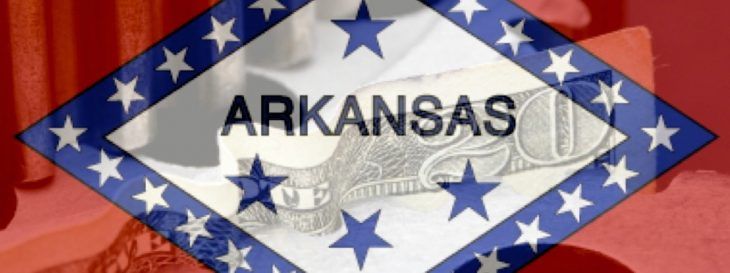InvestArk program: Source of highway funds, or effective jobs tool?
by February 14, 2016 2:48 pm 299 views

Gov. Asa Hutchinson (R) has floated the idea of cutting the state’s largest economic development incentive program as a funding source for highways, but the idea is being resisted by those who say the program cuts the cost of manufacturing plant upgrades and helps retain jobs in Arkansas.
Created in 1985, InvestArk provides existing Arkansas companies a 7% tax credit if they invest at least $5 million in upgrading and modernizing equipment. The credit can be applied to up to half of the company’s sales tax liability for a given year and can be spread over five years. It was originally designed for manufacturers but since has been expanded to corporate headquarters, call centers and other facilities.
In announcing his plan to find money for Arkansas highways without a tax increase Jan. 19, Hutchinson said some funding would come from efficiencies in state government. He later told the Arkansas Democrat-Gazette that one potential source of funding might come from cutting the InvestArk program.
Ending the program would save the state $1.5 million in fiscal 2017; $8.1 million in 2018; $14.6 million in 2019; $21.3 million in 2020; and $25.9 million in 2021, according to Jake Bleed, Department of Finance and Administration spokesman.
THE BEST ECONOMIC DEVELOPMENT TOOL?
Sen. Jake Files, R-Fort Smith, chairman of the Senate Revenue and Tax Committee, said legislators are open to the governor’s plan – and he is too, as long as the reduced InvestArk funding is replaced with more effective economic development tools.
“It’s an odd mix for me because I don’t want to do anything to compromise economic development, but is this really the best economic development tool we have as well?” he said.
A report prepared Oct. 16 by Arkansas Legislative Audit reviewed 50 projects that had received incentives totaling $39.1 million from 2003 through 2012. Those incentives had helped create 1,863 new full-time jobs paying $49.7 million in the final year of the project. Thirty-three of the 50 projects had negative cost-benefit ratios, and of those, 22 had received only the InvestArk incentive while another two had also received an Advantage Arkansas incentive, which is an income tax credit tied to job creation.
While some other incentives are tied to job creation, InvestArk is not. In fact, modernizing a plant can lead to job reduction because the plant becomes more efficient, the report said.
Legislative Audit assumed that all jobs created by companies receiving the incentives would not have happened if the incentives didn’t exist. It admitted in the report that such an occurrence was unlikely. The report also said it was more limited than an audit performed in accordance with government auditing standards issued by the United States comptroller general.
InvestArk is the largest of nine economic development tax incentive programs reviewed for the report. From July 1, 2003, to Dec. 31, 2014, those incentives together had amounted to $571.3 million, a number that can increase as companies become eligible based on their performance. InvestArk incentives was $341 million of that amount, or almost 60%.
SUPPORTERS: INVESTARK HELPS PLANTS REMAIN MODERN
Supporters of the InvestArk program say the report does not tell the whole story. On Tuesday, representatives from four large Arkansas manufacturers along with Randy Zook, president and CEO of the Arkansas State Chamber of Commerce and the Associated Industries of Arkansas, met with Hutchinson to state their case as to why the program should be retained.
Zook said in an interview that InvestArk is intended to mitigate the effects of Arkansas’ sales taxes that are applied to businesses during the production process. Arkansas is one of only 10 states that tax manufacturing machinery and equipment. None of the surrounding states imposes such a tax except Mississippi, which has lowered its tax to 1.5%.
The sales tax, he said, hits hardest capital-intensive, large manufacturers that are some of the state’s biggest employers.
“InvestArk is a Band-Aid for bad tax policy,” he said.
Arkansas Economic Development Commission numbers supplied by Zook show that almost $110 million in InvestArk credits were distributed to Arkansas companies in 2012-14. The largest was Tyson Foods, which received $12.32 million in credits.
Zook acknowledged that InvestArk doesn’t create many jobs and modernizing a plant can reduce jobs. However, the alternative is to lose the plants entirely in some cases, because plants are often competing against facilities in other states from within the same company. Zook said the InvestArk tax credit helped save the Cooper Tire plant in Texarkana when the company closed two mills in other states.
“You want those plants to be as modern and as competitive as possible,” he said. “Otherwise they die. They go away. Think Whirlpool. Think International Paper in Camden. Or just go around the state.”
Other benefits of the credit include construction activity and higher property taxes because the plants have higher value because of the new investments.
All of the state’s economic development incentives are now being studied. In an interview with reporters after addressing economic developers Feb. 4, Hutchinson said, “I’ve asked (AEDC Director) Mike Preston to review our economic incentives, and InvestArk is one of those. … We’re still in discussions, but that is something that is still being reviewed.”
In an emailed statement, Preston said, “In an effort to remain competitive it’s wise for the Arkansas Economic Development Commission and the governor to periodically review Arkansas’ incentive programs to ensure they meet the needs of today’s businesses as well as provide the best cost benefit for our taxpayers. Fiscal responsibility being one of our agency’s core values, we want to make sure that we are tracking our incentive dollars as accurately as possible and know what return on investment we are getting every time we use an incentive.”
